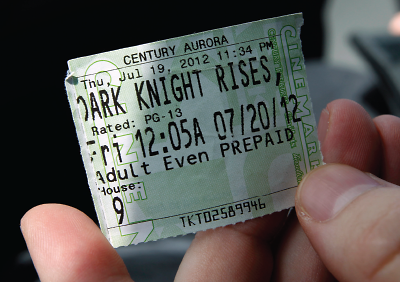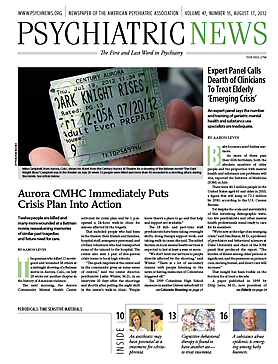The gunman who killed 12 moviegoers and wounded 58 others at a midnight showing of a Batman movie in Aurora, Colo., on July 20 wrote yet another chapter in the history of American violence.
The next morning, the Aurora Community Mental Health Center activated its crisis plan and by 1 p.m. opened a 24-hour walk-in clinic for anyone affected by the tragedy.
That included people who had been in the theater, their friends and families, hospital staff, emergency personnel, and civilian volunteers who had transported some of the injured to the hospital. The center also sent a pair of five-person crisis teams to local high schools.
“The quick response at the center and in the community gives us some sense of control,” said the center director, psychiatrist Leslie Winter, M.D., in an interview 10 days after the shootings and shortly after pulling the night shift in the center’s walk-in clinic. “People know there’s a place to go and that help and support are available.”
The 18 full- and part-time staff psychiatrists have been taking overnight shifts, doing therapy support work, and taking walk-in cases, she said. The added burden on local mental health services is expected to last at least a year or more.
“We don’t limit our services to people directly affected by the shooting,” said Winter. “There is a lot of secondary trauma with people listening to the news or having memories of Columbine triggered off.”
The 1999 Columbine High School massacre in another Denver suburb left 15 dead. “We’re seeing an increase in referred and self-identified people with Columbine exposure,” said Donald Bechtold, M.D.
Bechtold was a faculty member at the University of Colorado in 1999 and helped out at the Jefferson Center for Mental Health in Wheat Ridge, Colo., which was the focal point for mental health response to the Columbine tragedy.
Clinicians back then screened students and others exposed to the event, said Bechtold, now vice president and medical director at the Jefferson Center.
“We supported safe, neutral places for people in the community to come together to talk,” he said. “We did some psychoeducation to help them understand their reactions and let them know that [their reaction to the shootings] would be a long-term issue that would change over time and not resolve right away.”
Each situation is different and requires a different response, said Bechtold. For instance, Columbine took place in one high school, while the victims in the Aurora movie theater came from a number of schools, colleges, and workplaces.
The primary lesson from Columbine was not some clinical pearl, he said. “It’s the need for communities and states to have good disaster plans in place, so that when an event happens, you’re not left to scramble.”
As part of those plans, Jefferson had a group of licensed clinicians who had volunteered well in advance of the Aurora incident to serve wherever they might be needed. Jefferson supported their time and covered their schedules while they were in Aurora.
A week after the shooting, in a Centennial, Colo., courtroom, James Holmes, a former graduate student in neuroscience at the University of Colorado, Denver, was charged with 24 counts of murder and 116 counts of attempted murder, plus weapons and explosives charges. A trial is not expected before next year.
Judge William Sylvester scheduled a hearing for August 9 on the gag order that has kept nearly all information about the case under wraps. An August 16 hearing was scheduled to address the status of a notebook Holmes allegedly mailed to Lynne Fenton, M.D., a university student health service psychiatrist first identified by defense lawyers as having seen Holmes.
Some media commentators criticized Fenton for failing to predict or prevent the violence.
Such criticism is misplaced, said former APA President Paul Appelbaum, M.D., the Dollard Professor of Psychiatry, Medicine, and Law and director of the Division of Law, Ethics, and Psychiatry in the Department of Psychiatry at Columbia University College of Physicians and Surgeons.
For one thing, almost nothing is publicly known so far about Holmes’ condition or Fenton’s professional interaction with him, he said.
“Was Holmes seen once or over a period of time?” said Appelbaum. “What was the presenting problem? What, if any, treatment was provided? We don’t know.”
At Psychiatric News’ press time, the Associated Press, citing a Denver TV station, reported that early in June Fenton had notified members of the university’s Behavior Evaluation and Threat Assessment team about Holmes. The team did not meet to discuss his case because Holmes dropped out of the school on June 10.
Regarding the notebook’s status, some therapist-patient communications are protected from disclosure and some are not, said Appelbaum. If the notebook was sent in connection with treatment, it would remain privileged. But if it was seen as, say, a farewell message from the patient, it would not. In such cases, the judge alone reviews the material and decides whether it is privileged.
In any case, if a defendant asserts an insanity defense, privilege may be abrogated and the psychiatrist can testify at trial, he said.
As the judicial process moves ahead slowly, work continues at the Aurora Community Mental Health Center. Winter and her staff are prepared for the months of work ahead.
“The goal of the killer was to separate people,” she said. “So it’s a defiant act to bond and heal together.”


